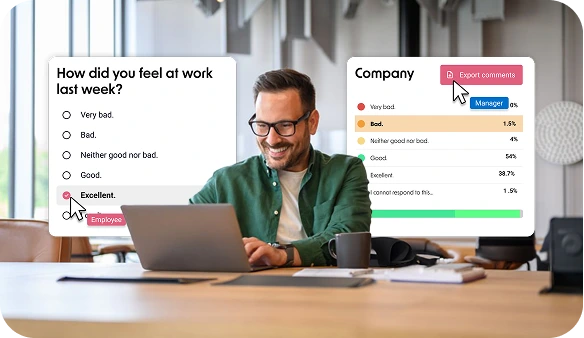Leadership Development Strategies That Actually Work (Backed By Feedback Data)

Leadership expectations are evolving quickly, and traditional training alone cannot keep up. Organisations today need agile, data-informed ways to build stronger leaders and more connected teams. That is where HeartCount helps companies turn employee feedback into clear insights that drive growth and engagement.
A peer-reviewed study, Maximizing the Impact and ROI of Leadership Development, found that structured, well-designed programs lead to measurable improvements in organisational performance. The research supports what we see every day: the most effective leadership development strategies rely on continuous learning, regular feedback, and practical application that deliver real business results.
This guide explores what makes leadership development sustainable, from design and measurement to long-term refinement through feedback that links people growth to company success.
-
1.Why a Strong Leadership Development Strategy Matters
-
2.10 Leadership Development Strategies That Actually Work
-
3.5 Core Benefits of Strong Leadership Development
-
4.Signs Your Leadership Development Strategy Isn’t Working
-
5.Challenges In Leadership Development And How To Overcome Them
-
6.How to Build a Leadership Development Strategy That Works
-
7.How HeartCount Enables Leadership Development That Sticks
-
8.How to Measure the Impact of Your Leadership Strategy
-
9.Final Thoughts
-
10.Frequently Asked Questions (FAQ)
Leadership expectations are evolving quickly, and traditional training alone cannot keep up. Organisations today need agile, data-informed ways to build stronger leaders and more connected teams. That is where HeartCount helps companies turn employee feedback into clear insights that drive growth and engagement.
A peer-reviewed study, Maximizing the Impact and ROI of Leadership Development, found that structured, well-designed programs lead to measurable improvements in organisational performance. The research supports what we see every day: the most effective leadership development strategies rely on continuous learning, regular feedback, and practical application that deliver real business results.
This guide explores what makes leadership development sustainable, from design and measurement to long-term refinement through feedback that links people growth to company success.
Why a Strong Leadership Development Strategy Matters
Leadership development is one of the most powerful drivers of organisational success. With rapid shifts in technology, hybrid work, and rising employee expectations, companies need adaptable, emotionally intelligent leaders. Yet according to McKinsey & Company, only 11% of executives believe their current leadership efforts deliver meaningful results.
Traditional, once-a-year training programs cannot keep up with this pace of change. Real progress happens when development becomes a continuous practice, supported by feedback and measurable outcomes. Insights from the HeartCount turnover and retention insights guide show that when companies actively grow their managers through regular feedback, engagement rises, burnout falls, and retention improves.
What Is a Leadership Development Strategy
A leadership development strategy is a structured plan that helps organisations grow capable, confident leaders through continuous learning and feedback. It connects leadership behaviour with business goals and tracks how learning translates into impact. Using data-driven insights, HR teams can see how leadership quality affects engagement, wellbeing, and team stability across the organisation.
Leadership Development Drives Retention and Engagement
Employees rarely leave companies; they leave poor leadership. Clear strategies for leadership development build trust, communication, and psychological safety, helping people feel supported and valued. Research consistently shows that leadership behaviour explains most of the differences between highly engaged and low-performing teams.
Applying leadership skills development strategies such as coaching, recognition, and regular check-ins keeps motivation high and strengthens culture. With real-time feedback, leaders can see what works, address challenges early, and build long-term engagement.
Core Elements of an Effective Leadership Strategy
Every successful approach combines four essentials:
- Assessment: Identify leadership strengths and gaps.
- Alignment: Connect leadership goals to company priorities.
- Action: Apply learning through mentoring, coaching, and daily practice.
- Accountability: Measure progress and adjust continuously.
Empowering managers to use team leadership development strategies ensures learning happens naturally in everyday work. When recognition and reflection are part of the process, leadership growth becomes a consistent part of company culture, not a one-time event.
10 Leadership Development Strategies That Actually Work
Every successful leadership program needs practical steps that make those elements come to life. Below are ten proven leadership development strategies that help organisations turn good intentions into real, measurable growth.
1. Use Real-Time Feedback and Continuous Measurement
Leaders improve fastest when they can see the effects of their actions. Real-time feedback and short pulse surveys give instant visibility into what’s working. When data is reviewed regularly, growth becomes measurable and leadership development stays connected to real outcomes.
2. Link Development Goals to Business Results
Leadership growth should align with company priorities such as engagement, retention, and productivity. Connecting development plans to measurable results helps teams understand why leadership behaviour matters and how it supports overall performance.
3. Create Individualised Development Plans
Generic training doesn’t work. Leaders need plans that reflect their strengths, career goals, and learning styles. Tailored coaching and goal setting make growth feel achievable and relevant at every stage of a leader’s journey.
4. Encourage Peer Learning and Mentoring
Leaders learn a great deal from each other. Peer coaching builds trust, supports knowledge sharing, and keeps accountability strong. Informal conversations often teach as much as formal programs.
5. Make Engagement a Shared Responsibility
When leaders understand how their behaviour influences engagement, they take greater ownership of culture. Giving managers access to participation insights and recognition data makes that connection visible. Insights from employee participation trends can reveal what motivates teams and where leaders can step in to support them.
6. Hold Regular 1:1 Check-Ins
Consistent one-on-one conversations help leaders listen, coach, and remove roadblocks before they grow. Even 15 minutes can uncover development opportunities or morale issues. Use prompts from effective 1:1 meeting questions to keep the discussion focused and productive.
7. Offer Stretch Assignments to Build Confidence
Experience builds leadership faster than theory. Assigning high-impact projects or temporary roles allows managers to grow skills in real situations while maintaining a safety net of support and feedback.
8. Foster Psychological Safety Across Teams
Trust is the foundation of leadership. When leaders feel safe to ask for help or admit mistakes, they create that same safety for their teams. A culture built on openness encourages honest feedback and long-term job satisfaction, as seen in research on employee job satisfaction.
9. Recognise Progress and Everyday Wins
Recognition should highlight growth, not just big results. Simple acknowledgements such as a quick thank-you message or public appreciation reinforce positive behaviour and boost motivation. Recognition is one of the easiest ways to maintain energy across teams.
10. Use Data to Refine and Evolve Your Strategy
A leadership strategy should evolve alongside the business. Reviewing engagement and performance metrics helps organisations understand what’s working and where to adjust. Tracking employee productivity over time also reveals how leadership development translates into measurable results.

COLLECT
5 Core Benefits of Strong Leadership Development
When leadership development is done right, everyone benefits, from individual employees to the entire organisation. A clear and consistent strategy strengthens culture, builds trust, and drives measurable results. Tools that make recognition and feedback easier help leaders turn insight into action and keep engagement high.
1. Boosts Engagement and Team Morale
Strong leadership gives people clarity and direction. When managers communicate openly and consistently recognise effort, morale improves and teams feel more connected to shared goals. Employees who feel supported are more likely to stay engaged and bring energy to their work. Research on the benefits of employee engagement shows that recognition, clear communication, and meaningful feedback lift motivation and improve performance.
2. Builds a Ready Pipeline for Succession
Consistent development prepares future leaders before they are needed. Organisations that focus on long-term growth can promote from within instead of rushing to hire externally. This stability strengthens business continuity and keeps teams confident about their future.
3. Increases Retention and Reduces Burnout
Leaders who listen, delegate well, and manage workloads fairly help prevent burnout. Employees stay longer when they trust their managers to support balance and wellbeing. Leadership growth directly improves retention and job satisfaction across the organisation.
4. Strengthens Organisational Culture and Alignment
A leadership strategy that reflects company values builds unity. When leaders model transparency, inclusion, and accountability, those behaviours spread through teams. The result is a more connected culture that supports shared goals.
5. Improves Performance Across Roles
Good leadership connects personal development with organisational success. Regular coaching, feedback, and recognition help teams improve together. Real-time insights from platforms like HeartCount’s employee recognition feature show which actions have the strongest impact on performance.
Of course, even the best leadership programs can lose momentum without regular evaluation. Knowing what warning signs to watch for helps leaders course-correct before engagement suffers.

Signs Your Leadership Development Strategy Isn’t Working
Even the strongest programs can lose momentum if they aren’t reviewed and refined. Recognising early warning signs helps leaders adapt before morale and performance decline. Sentiment data, feedback, and engagement trends can reveal when your approach needs a reset. Teams often start to show the same patterns you’d see in signs of an overworked employee: fatigue, low motivation, and lack of trust in leadership.
Leaders Struggle to Inspire or Retain Teams
If turnover rises or energy drops, leadership gaps might be to blame. Managers who lack coaching support or regular feedback tend to focus on tasks instead of people. Over time, motivation fades and recognition disappears.
Watch for:
- Team members disengaging during meetings
- Less collaboration or visible enthusiasm
- Fewer moments of praise or celebration
Low Scores on Engagement or Sentiment Surveys
If engagement scores stay low, employees may not feel heard or supported. Leadership development should lift these numbers by improving communication and trust. When results stay flat, it suggests that training isn’t translating into real behaviour change.
Look for:
- Poor communication or trust ratings
- Declining wellbeing or satisfaction metrics
- Feedback that goes unaddressed for several cycles
High Performer Turnover or Plateauing Growth
When high performers start leaving, leadership support is often missing. A lack of growth opportunities or recognition can make top talent feel invisible. Teams thrive when managers delegate responsibility and invest in their people’s careers.
Resistance to Change or Low Buy-In
If employees resist new initiatives, leadership alignment is likely weak. A strategy that only focuses on skills but not communication or culture won’t inspire lasting engagement. Strong leaders create clarity and consistency so change feels manageable, not forced.
Challenges In Leadership Development And How To Overcome Them
Even strong programs can lose impact if they overlook day-to-day realities. The biggest challenges usually come from generic content, slow feedback, and lack of alignment. Here’s how to spot them and adjust fast.
Challenge 1: Generic, One-Size-Fits-All Programs
Leadership growth stalls when everyone gets the same training. First-time managers, mid-level leaders, and executives face very different situations and need tailored support.
How to fix it: Create flexible learning paths that reflect each role and career stage. Combine short lessons with mentoring or peer sessions that connect directly to daily challenges.
Challenge 2: Lack of Real-Time Insight for Managers
Annual reviews don’t show what’s really happening inside teams. Without live feedback, managers miss early signs of disengagement or burnout.
How to fix it: Build continuous feedback cycles that help managers see progress in real time. Regular check-ins, short surveys, and open conversations keep strategies grounded in what employees actually need. A consistent feedback loop helps leaders act on insights before small issues turn into larger problems.
Challenge 3: Misalignment Between HR and Executives
HR might design great programs, but without executive support they rarely last. Senior leaders define priorities, and if they don’t model the behaviours being taught, the message falls flat.
How to fix it: Get leaders involved from the start. Tie development goals to measurable business outcomes and share progress updates regularly. When executives see results that support strategy, commitment grows naturally.
Challenge 4: No Feedback Loop to Track Impact
Training that ends at the classroom door loses value quickly. Without measurement, it’s impossible to know whether leadership behaviours are improving.
How to fix it: Keep gathering feedback after each learning phase. Frequent pulse surveys and reflection sessions help teams track progress and celebrate wins. Over time, this creates a living system of accountability and continuous improvement.
UNDERSTAND
How to Build a Leadership Development Strategy That Works
A great leadership development strategy is built on clarity, consistency, and continuous learning. It moves beyond one-time workshops and creates an ongoing rhythm of reflection, feedback, and measurable growth. The most successful programs follow a simple pattern: listen, act, measure, and refine.
1. Start With Feedback and Pulse Survey Data
Leadership improvement begins with understanding how teams feel. Frequent pulse surveys reveal what employees think about communication, recognition, and workload. Tools such as employee pulse check surveys make this process effortless and give leaders early visibility into morale trends. Tracking signals like trust in leadership or workload fairness helps identify areas that need attention before issues spread.
2. Align Leadership Goals With Business Strategy
Leadership development should directly support company priorities such as innovation, retention, or culture. Defining how leadership behaviour contributes to those outcomes makes progress easier to measure and justify. Ask, “Which behaviours will move our organisation forward right now?” and shape learning objectives around those answers.
3. Tailor Learning Paths to Role Levels and Needs
Different levels of leadership face different challenges. New managers often need coaching and communication practice, while experienced leaders benefit from strategic thinking and change management. Personalised learning paths keep development relevant and actionable, combining short-term coaching with hands-on learning.
4. Empower Managers With Continuous Insights
Managers need visibility to lead effectively. Regular feedback loops and quick data snapshots keep them aware of team sentiment and engagement. Using employee feedback templates allows leaders to gather targeted insights and adjust faster, creating a habit of continuous improvement.
5. Use Real-Time Alerts to Detect Risk Early
When engagement or motivation begins to drop, early detection prevents larger problems. Real-time alerts help managers step in quickly with a conversation, workload adjustment, or recognition moment. Acting early builds trust and keeps morale stable.
6. Close the Loop and Keep Improving
Leadership development is never complete. Continue measuring progress, collecting feedback, and sharing updates with teams. When employees see their input turn into visible change, participation and trust grow stronger. Everyday habits like coaching, reflection, and recognition, supported by resources on employee growth and development ideas, keep leadership learning consistent and relevant.
How HeartCount Enables Leadership Development That Sticks
Leadership growth lasts only when it’s reinforced every week. HeartCount helps organisations keep that rhythm by linking continuous feedback with visibility and action. It turns leadership development into an ongoing system instead of a single event.
Weekly Pulse Surveys Drive Continuous Learning
Short, recurring surveys help leaders stay tuned in to how their teams feel. Regular check-ins create a rhythm of reflection that most programs overlook. Acting on this feedback strengthens trust and builds a genuine culture of collaboration.
Burnout and Disengagement Alerts Keep Leaders Proactive
When teams begin to feel overstretched, early signals appear in pulse results and written comments. Real-time alerts help managers respond early, rebalance workloads, and maintain morale before motivation dips.
Anonymous Feedback Supports Psychological Safety
Some employees hesitate to speak up about leadership challenges. Anonymous feedback options encourage honesty, helping managers see what’s really happening and respond with empathy.
Dashboards Help Managers Spot Gaps Fast
Data becomes meaningful only when it’s easy to interpret. The Employees Overview dashboard gives managers a clear picture of engagement, recognition, and workload trends across teams. These insights connect leadership actions to real-world outcomes, making it easier to adjust strategies and measure progress.
ACT
How to Measure the Impact of Your Leadership Strategy
A strong leadership strategy should deliver measurable change. Tracking the right data helps organisations understand whether development efforts are improving communication, retention, and culture. These insights turn leadership growth from an assumption into clear evidence.
Employee Sentiment and Engagement Trends
Engagement is one of the clearest signs of leadership success. Monitoring results through tools such as the employee engagement index shows whether leaders are improving recognition, collaboration, and trust. When engagement rises steadily, it signals that leadership behaviours are translating into stronger team performance.
Retention and Promotion Rates
Healthy leadership pipelines show up in retention and internal mobility data. Fewer resignations and more internal promotions indicate that employees see long-term growth opportunities under their current managers. Exit and stay interviews can provide context to understand what drives these numbers.
Culture Alignment and Leadership Scorecards
Strong leadership should mirror company values. Tracking collaboration, inclusion, and accountability through leadership scorecards reveals whether those principles are reflected in day-to-day behaviour. Consistency here shows that development is shaping the wider culture, not just individual performance.
Leadership Bench Strength and Succession Readiness
A successful program ensures the next generation of leaders is ready to step up. Measuring bench strength helps determine how quickly critical roles can be filled and whether leadership knowledge is being shared across teams. This readiness is a key sign of sustainable development.
Keep Measurement Loops Tight
Regular reviews keep your data meaningful. Comparing participation and survey completion rates helps confirm that results truly represent your workforce. Monitoring your survey response rate ensures feedback remains accurate and complete. The closer the loop between collecting data and acting on it, the stronger the impact of your leadership strategy becomes.
Final Thoughts
Leadership development is never a one-time effort. The most effective programs grow alongside the people and culture they support. By combining clear goals, actionable data, and a commitment to continuous learning, organisations can build leaders who inspire confidence and drive long-term success.
When development is measurable and aligned with real outcomes, leadership becomes more than a skill. It becomes part of how the organisation thinks, collaborates, and evolves.
Frequently Asked Questions (FAQ)
What are the most effective leadership development strategies?
The most effective leadership development strategies combine continuous feedback, coaching, and clear alignment with company goals. Instead of one-off training sessions, they focus on weekly insights, data-driven decisions, and consistent recognition to help leaders grow alongside their teams.
How do you measure leadership growth over time?
Leadership growth is best measured through engagement metrics, sentiment scores, and promotion data. Regular surveys and feedback loops help track how leadership behaviour influences team trust, motivation, and performance.
How often should you review a leadership development plan?
Review your plan at least quarterly to keep it relevant. Regular check-ins ensure learning goals stay aligned with business priorities and team needs. Continuous listening and adaptation keep your leadership development strategies effective long term.
What tools help track leadership development progress?
Use digital tools that combine surveys, analytics, and feedback tracking in one place. Platforms like HeartCount simplify this process by providing real-time data, helping HR teams monitor progress and adjust development paths quickly.










